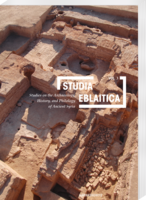|
|
more titles of the subject:
The aim of this new international journal is to contribute to developing the study of the interpretation and understanding of the ancient cultures of Syria, remaining as open as possible to the different methodologies and problems that characterize present-day research.
Thanks to the generous policy of international collaboration pursued by the cultural authorities of the Syrian Arab Republic, the increase in archaeological research in Syria, particularly from the 1970s on, opened up a series of new perspectives on the study of ancient Syria. The discovery of the Royal Archives of Ebla was decisive in this renaissance, as well as the role that Ebla played in establishing the very foundations of cultural development in ancient Syria. This project originates at a time of serious crisis for Syria, whose plight does not even spare the country’s magnificent, thousand-year-old cultural heritage. It is also intended as the strongest of hopes for a not-too-distant future of peace, prosperity, harmony and justice for the whole of the Syrian people. From the contents (altogether 13 contributions): Lynn Welton, Gap or Transition? Characterizing the Late Chalcolithic and Early Bronze I in the Amuq Plain Paolo Matthiae, The Victory Panel of Early Syrian Ebla: Finding, Structure, Dating Pelio Fronzaroli, Les pronoms éblaïtes de la première personne Neal A. Huddleston, Arbitrating the Ebla Treaty Tradition: A Discourse Analytic Approach Nathalie Kallas, The Construction of Power and the Production of Elite Identity: The Middle Bronze Age Palaces of the Levant Valentina Tumolo, Preliminary Notes on Some New Seal-Impressed Potsherds from Ebla Marco Bonechi, Notes on the Ebla Palace G Texts from L.8496 Marta D'Andrea, Note on Early Bronze IV Grey Hard-Textured Wares in the Levant Georges Mouamar, Tell Ṣabḥah: A Large Circular City of the 3rd Millennium BC in the Syrian Steppe (Shamiyah) |






